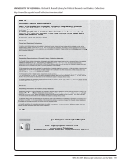98 · Survey Results: Survey Questions and Responses
Collections are accessible globally. Access can be unmediated. Enhances profile of university and of the
collections. Broader communications
with and alerts to university and offsite
researchers.
Dissemination &access. Optimal exploitation of our collections. Giving a great visibility to our
collections.
Dramatically higher use of the collection
resources. Last November 2007 our
reference numbers matched those for
the entire year of 1986.
Users know more about the collection
and how it works before coming in for
themselves or requesting services over
the phone or e-mail.
The unified system (our collection
management tool also serving as our
public interface) has eliminated a great
deal of confusion of users and our
records center staff.
Ease of access. Collection control and development. Less wear on materials.
Easier and quicker access to collection
descriptions for researchers both on
campus and worldwide.
Staff can better access information this
way. We usually go directly to NWDA
for encoded finding aids, not OUR Web
site.
Easy access for patrons and greater use
of manuscript materials.
Increased visibility of special collections
repositories.
Placing collections online has the
potential to generate new leads that
can help develop existing collections.
Facilitating independent discovery of
archival materials.
Finding aids uploaded to the
OAC become searchable across
collections and institutions, thereby
providing enhanced discoverability
for researchers. Searches may lead
to additional related resources not
otherwise discoverable.
Finding aids on the OAC are
discoverable through Google and other
broadly used search engines.
Finding aids provide a basis to which
digital surrogates may be linked.
Greater access for patrons able to
search subjects across collections and
institutions. With full finding aids on
the Web patron is able to indicate more
clearly exactly what they need.
Visibility of collecting areas for potential
donors.
A statistical analysis of collections
searched by patrons allows us to
determine the subjects researchers are
most interested in. This assists us in
collection development and in planning
which collections should be cataloged
next.
Greater access of collections for patrons
who are not onsite.
Greater awareness of our department’s
wonderful collections.
Greater access worldwide. Increased understanding from
researchers of our collections.
Ability to link related collections.
Greater access. Satisfied researchers. Feeling of accomplishment.
Collections are accessible globally. Access can be unmediated. Enhances profile of university and of the
collections. Broader communications
with and alerts to university and offsite
researchers.
Dissemination &access. Optimal exploitation of our collections. Giving a great visibility to our
collections.
Dramatically higher use of the collection
resources. Last November 2007 our
reference numbers matched those for
the entire year of 1986.
Users know more about the collection
and how it works before coming in for
themselves or requesting services over
the phone or e-mail.
The unified system (our collection
management tool also serving as our
public interface) has eliminated a great
deal of confusion of users and our
records center staff.
Ease of access. Collection control and development. Less wear on materials.
Easier and quicker access to collection
descriptions for researchers both on
campus and worldwide.
Staff can better access information this
way. We usually go directly to NWDA
for encoded finding aids, not OUR Web
site.
Easy access for patrons and greater use
of manuscript materials.
Increased visibility of special collections
repositories.
Placing collections online has the
potential to generate new leads that
can help develop existing collections.
Facilitating independent discovery of
archival materials.
Finding aids uploaded to the
OAC become searchable across
collections and institutions, thereby
providing enhanced discoverability
for researchers. Searches may lead
to additional related resources not
otherwise discoverable.
Finding aids on the OAC are
discoverable through Google and other
broadly used search engines.
Finding aids provide a basis to which
digital surrogates may be linked.
Greater access for patrons able to
search subjects across collections and
institutions. With full finding aids on
the Web patron is able to indicate more
clearly exactly what they need.
Visibility of collecting areas for potential
donors.
A statistical analysis of collections
searched by patrons allows us to
determine the subjects researchers are
most interested in. This assists us in
collection development and in planning
which collections should be cataloged
next.
Greater access of collections for patrons
who are not onsite.
Greater awareness of our department’s
wonderful collections.
Greater access worldwide. Increased understanding from
researchers of our collections.
Ability to link related collections.
Greater access. Satisfied researchers. Feeling of accomplishment.








































































































































































































